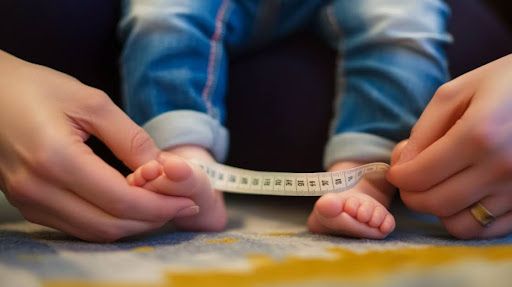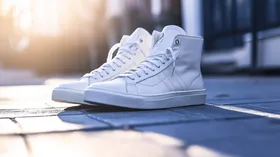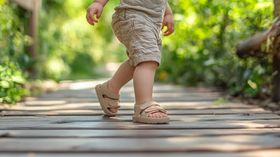Toddlers With Wide Feet: A Full Guide for Parents
Finding the perfect fit: The ultimate guide to choosing shoes for your toddler with wide feet
Published January 19, 2025

When you notice your toddler's feet seem wider than those of other children, it's natural to have questions about what this means for their development. Taking the right steps to care for wide feet during childhood can have lasting effects on your little one's comfort and mobility.
Let's explore the essential aspects of managing and supporting your child's wide feet, from daily routines to long-term planning.
» Give your child's feet the space they need with shoes for wide feet
Understanding Wide Feet in Toddlers
Wide feet in toddlers are characterised by a broader forefoot area that often extends beyond standard width measurements. While this can be a natural part of development, it's essential to understand that toddlers' feet are still growing and forming.
Their feet tend to have a softer, more rounded shape by nature, which can sometimes appear wider than adult proportions would suggest.
The primary factors that contribute to wide feet in toddlers include:
- Genetics: Your child's genetic predisposition plays a fundamental role in determining foot width, as kids often inherit foot characteristics and structure directly from their parents.
- Weight: Higher body weight can influence foot width, as the feet naturally spread to provide better balance and distribute pressure more evenly across the surface.
- Development: Early development patterns and milestones can significantly affect foot structure, including when and how a child begins walking or crawling.
- Environmental Factors: Footwear choices and the types of surfaces a child regularly walks on significantly influence foot development. For instance, restrictive footwear on hard surfaces can impede natural foot movement and potentially affect foot shape.
» Learn how to measure your child's feet for shoes
Does My Child Have Wide Feet?
Identifying whether your child has wide feet can help you make informed decisions about their footwear and care needs. While a professional measurement is the most accurate method, parents can observe several telling signs at home.
- Visible Signs: Watch for bulging or pressure marks on the sides of their current shoes, even when the length fits correctly. Red marks or indentations on the sides of their feet after removing shoes can also indicate a width issue.
- Measurement Indicators: When professionally measured, feet that fall into width categories like "2E" or wider typically indicate wide feet. Remember that feet are often widest at the end of the day.
- Behavioural Clues: Children with wide feet might frequently try to remove their shoes, complain about foot discomfort, or show reluctance to wear specific footwear.
- Physical Appearance: The forefoot area (near the toes) appears notably broader than the heel, and their feet may have a particularly soft, rounded appearance compared to other children their age.
» Learn what's normal (and what's not) in your toddler's walking journey
Do Wide Feet Impact Daily Life?
Living with wide feet can present unique challenges for toddlers and their parents. Understanding these challenges is the first step in addressing them effectively.
Walking patterns often show distinctive characteristics in toddlers with wide feet. Here's what parents should watch for:
- Wider Stance: Toddlers with wide feet may naturally adopt a wider stance while walking to maintain better balance and stability.
- Early Fatigue: Some may experience early fatigue during extended walking periods due to the extra effort required to maintain proper foot positioning.
- Temporary Balance Challenges: People with temporary balance challenges might have slightly different balance and coordination than their peers, especially when learning new physical skills or activities.
» Check out the best shoes for babies learning to walk
Long-Term Considerations
Without proper attention, wide feet can impact various aspects of development and comfort. The most significant long-term considerations include postural alignment and foot health:
- Improper shoe choices during early years can lead to lasting changes in walking patterns and overall posture alignment.
- Consistent compression of wide feet in narrow shoes may contribute to the development of bunions or other foot deformities over time.
- Children might develop compensatory movements that could affect their spine and lower body alignment as they grow.
» Understand the different gait abnormalities in children
Essential Footwear Guidelines
Given these potential long-term impacts, choosing supportive footwear is paramount. The right shoes are crucial to their comfort, development, and overall well-being. Conversely, poor shoe choices can have significant negative consequences, including discomfort, foot deformities, and postural problems.
When shopping for shoes, look for these critical features:
- Spacious Toe Box: Ensure ample room for toes to spread naturally. This allows for proper muscle development and balance and prevents crowding that can lead to deformities like bunions or hammertoes.
- Adjustable Closures: Look for shoes with Velcro straps or laces. These allow for customising the fit across different parts of the foot, ensuring a snug and comfortable fit without any pressure points.
- Flexible and Supportive Sole: The sole should be flexible enough to allow for natural foot movement while providing adequate support to protect growing feet from impact.
- Breathable and Adaptable Materials: Opt for shoes made from breathable materials like leather or mesh to prevent moisture buildup and accommodate foot swelling throughout the day.
Daily Care and Maintenance
A proper care routine is essential for maintaining healthy feet and preventing potential issues. Regular attention to foot health can prevent many common problems before they develop.
Essential daily care practices include:
- Regular foot inspection should be performed daily to check for signs of pressure marks, redness, or irritation from shoes.
- Proper hygiene must be maintained through thorough washing and careful drying, with special attention to the spaces between toes.
- Scheduled breaks from shoes allow feet to breathe and strengthen naturally in safe, controlled environments.
- Gentle foot exercises can be incorporated into daily routines to promote foot strength and flexibility.
» Explore these child feet care points every parent should know
Growth and Development Patterns
Understanding how wide feet might change over time helps parents prepare for their child's future needs. While some children's feet become more proportional as they develop, others maintain wider feet into adulthood.
Growth patterns typically follow these trends:
- Significant changes in foot structure often happen between ages four and six, particularly in arch development.
- Regular monitoring of foot growth and width changes helps ensure proper shoe sizing throughout development.
- Environmental factors and activity levels during early years can influence foot width development.
» Check out the difference between regular and supportive shoes
When to Seek Professional Help
While wide feet are often normal, there are specific situations that warrant professional evaluation. Awareness of these signs can help parents make timely decisions about seeking expert advice.
Key indicators that suggest the need for professional assessment include:
- Your child experiences persistent pain or discomfort while walking or running, even when wearing shoes correctly sized to accommodate their foot width.
- You notice significant redness, swelling, or skin irritation that doesn't improve with better-fitting shoes or regular foot care routines.
- Your toddler shows signs of balance issues or frequently stumbles beyond what's typical for their age group and developmental stage.
- The stiffness in the feet or ankles seems to affect their mobility and daily activities.
» Give your busy explorer enough support for everyday play
Embracing Unique Foot Development
As your toddler grows and develops, their wide feet will continue to evolve and adapt. The care and attention you provide during these early years—from choosing the right shoes to maintaining proper foot care—create a foundation for lifelong foot health.
Monitor their progress, stay flexible in your approach, and adjust your care strategies as needed. With proper support and understanding, your child's wide feet won't be a limitation but another unique aspect of their physical development.
» Don't let tight shoes hold your child back. Discover wide-fit shoes today
Disclaimer: First Walkers' information is intended for educational and informational purposes related to toddler footwear and feet. We encourage you to consider individual circumstances and consult qualified orthopaedists about specific conditions.





